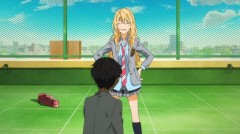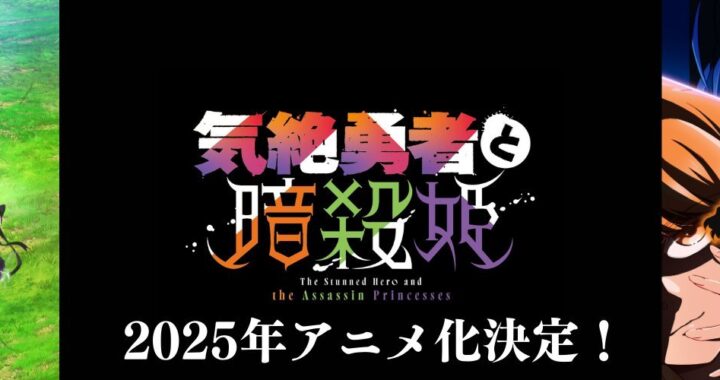 One of the more heartbreakingly beautiful series of the past decade in both story and visuals.
One of the more heartbreakingly beautiful series of the past decade in both story and visuals.
What They Say:
Kousei Arima was a genius pianist until his mother’s death robbed him of his will to play. Since that day, Kousei has lived a dull, empty life. However, when he meets a peculiar violinist named Kaori Miyazono, her independence, carefree attitude, occasionally short temper, and eccentric playing style fascinate the former musician. His monotonous life is about to change forever.
Your Lie in April Complete Box Set contains anime episodes 1-22 of the anime directed by Kyohei Ishiguro and includes 13 Collectible Illustration Cards.
The Review:
Audio:
The audio presentation for this release is definitely one that’s done well as we get the original Japanese language track and the English language adaptation in stereo using the uncompressed PCM design. The show is one that works some real magic when it comes to the soundtrack itself with the music and giving it a clean and uncompressed form like this is an important thing – especially since it’s done for both languages. The series works a very rich and warm approach with the detailed music and it definitely creates that right kind of magical feeling. This helps to elevate the dialogue side itself, which is a bit standard since there’s not much here out of the ordinary. But the combination of the two, some of the internal dialogue, and just the overall push from the mix helps to raise it to the next level in a very good way.
Video:
Originally airing in 2014 and 2015, the transfer for this TV series is presented in its original aspect ratio of 1.78:1 in 1080p using the AVC codec. The twenty-two episodes in this set are spread across six discs in a three/four/four/four/four/three format. Animated by A-1 Pictures, the series is simply gorgeous with everything it does from top to bottom. With the discs only having a few episodes to them, the bit rate is pretty high across the board and everything is simply captured in a way that for the vast majority of viewers will be perfect. The colors are rich and layered, there’s a great amount of detail throughout, and the backgrounds have a richness about them that helps to make it feel all the more authentic. While the music is the thing here, the animation is just as important in giving it the life it needs and there’s just such a richness and smoothness to all of this that it’s beautiful. The character designs are wonderful with so much to them while still staying simple in terms of costume, but it knows when to expand.
Packaging:
The packaging for this release brings us two clear Blu-ray cases inside a soft box to hold it all together. I do wish it was a heavy chipboard box as the show warrants it, but the set looks good here overall. The front of the box plays to the soft blues and pinks as the main indistinct background image while there’s a small photograph style image in the upper middle that lets us enjoy the four main characters in a really good way. It’s simple and a bit unusual since you’d normally get a full cover visual, but the minimal aspect works for me with the overall color design. That’s extended to the back but we get a larger visual with the familiar playing and singing on the water piece, which is a medium-length shot here. It has the summary of the premise in white across it which you can read fairly easily. The rest is pretty busy but it covers the episode count, the extras, and all the production credits and technical grid. The majority of it is so small that you can barely read it but it’s at least there.
While the original sets had a lot going on with the Blu-ray cases inside the box, this one goes a lot simpler. One is pink and one is blue as it uses the same kind of snowflake design to on both sides and both front and back. The spine has some text to let you know which set it is and what it covers, but it’s pretty simple beyond that and very, very minimal. Beyond that, the set comes with a really fantastic set of postcards from the show which are definitely worth putting together in a frame to display. They’re slick and colorful in a great way.
Menu:
The menus for this release takes its cues from the illustration side once again as well to good effect as the same pieces used as the postcards are done up across the three discs. The larger look at the artwork here is fantastic and there’s a real richness to the detail and warmth that comes from it. Each menu looks great, though the navigation itself is a little too detailed. It’s setup as piano keys where the selections align over the keys themselves, making it a little hard to read from time to time. The layout itself looks good and I like the concept of it, but it was just a little rough in actual presentation as there’s simply too much detail. Navigation itself is smooth and problem-free both as a top-level menu and as a pop-up menu.
Extras:
The extras for this release on-disc are pretty minimal overall as we get the clean version of the opening and closing sequences as well as a brief but fun segment of English bloopers. The big extra for a lot of folks will be the audio commentary for the first episode and twenty-second episodes of the series with the English cast and director.
Based on the manga Shigatsu wa Kimi no Uso by Naoshi Arakawa, Your Lie in April is a twenty-two-episode series of which we get the first half of here. Animated by A-1 Pictures, the series garnered a lot of critical acclaim during its broadcast and simulcast run as it drew in audiences in a big way. The manga itself ran from 2011 to 2015 with eleven volumes total, ending just before the anime itself finished out. Having not read the manga nor seen the simulcast, I was originally able to go into the series without any real preconceptions other than hearing nothing but great about it. And within just the first episode or two at most I found myself really getting into it. With this new viewing of it, I’m still of the mind that this is one of the best series of this nature that I’ve seen in the past decade. It’s not flawless and there are areas where it could be tightened, but as it adapts and brings to life the manga, it’s fantastic.
The series takes place with a group of end of middle school kids that are all dealing with their own issues. There’s a familiarity to it all to be sure because these are stories that anime covers constantly. But a familiar story can become magical in the right hands, such as the production team here and the source material itself. With four main characters, things are kept small yet expansive with what each of their stories are about. The simple nature is here. Kosei is a piano prodigy that has lost his ability to play, leaving him something of a quiet wreck. He’s got his best friend in Ryota, the captain of the soccer team that has dreams and plans of going worldwide and being a star. He’s got the confidence and skills to pull it off but he always makes sure that his friend is high on his list. Both of them are childhood friends of Tsubaki, Kosei’s next-door neighbor that’s a key part of the school softball team where she directs much of her energy. She’s a big part of Kosei’s life for obvious reasons and is continually concerned about him after the events of the last few years.
 When she sets up a date for Ryota and a new girl named Kaori, it all twists their lives into a tailspin. Kosei comes across her first and discovers that she’s a musical genius herself, though it’s not until later that he finds out that she’s a violinist. He falls for her even while realizing he’s Friend A – and she even calls him that from time to time. With this in play, Ryota’s smitten with her as well though he’s smart enough to see Kosei’s interest in her. Ryota is something of a playboy in a way as he dates multiple girls, so while he’s interested in Kaori at first it doesn’t feel like something real, which is what Kosei feels. Hell, Ryota tells Kosei to go after her even though he’s the one ostensibly with her at the moment as he says that just because they’re friends it doesn’t mean he can’t. Tsubaki’s role in all of this isn’t exactly complicated, but she goes from having her childhood friend and never thinking of him as anything more to realizing his attentions are directing elsewhere. That puts her into a difficult place as it gets all in her head and she doesn’t know what to do or what it really means. Kaori’s presence in all their lives, where she really is simply friendly and outgoing with them all, shakes up the dynamic so much with so little that it’s positively striking.
When she sets up a date for Ryota and a new girl named Kaori, it all twists their lives into a tailspin. Kosei comes across her first and discovers that she’s a musical genius herself, though it’s not until later that he finds out that she’s a violinist. He falls for her even while realizing he’s Friend A – and she even calls him that from time to time. With this in play, Ryota’s smitten with her as well though he’s smart enough to see Kosei’s interest in her. Ryota is something of a playboy in a way as he dates multiple girls, so while he’s interested in Kaori at first it doesn’t feel like something real, which is what Kosei feels. Hell, Ryota tells Kosei to go after her even though he’s the one ostensibly with her at the moment as he says that just because they’re friends it doesn’t mean he can’t. Tsubaki’s role in all of this isn’t exactly complicated, but she goes from having her childhood friend and never thinking of him as anything more to realizing his attentions are directing elsewhere. That puts her into a difficult place as it gets all in her head and she doesn’t know what to do or what it really means. Kaori’s presence in all their lives, where she really is simply friendly and outgoing with them all, shakes up the dynamic so much with so little that it’s positively striking.
And yes, utterly familiar. But that familiarity isn’t something that it leans on. Each of these characters generates a solid amount of focus with what they’re going through with what Kaori brings to it, but the primary focus is on Kaori and Kosei and more so with Kosei in this first half of the series. Kosei is something of a celebrity of sorts for what he accomplished as a child prodigy of the piano up through when he suddenly just quit mid-performance two years prior. That has others still seeing him as competition that they want to overcome, a piece that factors into the later episodes here. Kaori knows all this about him, though she hides that she knows it, and instead works on just trying to bring him back to the world of music. She somehow manages to convince him to accompany her with her competition performance and then later gets him to do a solo competition all on his own.

But these are all disasters for him because of what he’s suffering from in that once he really gets underway in playing he can’t hear the notes. It’s represented as a black sea that swallows him and the sound, making for some striking visuals for the terror that he feels. He is truly gifted and capable with a precision that earned him so much recognition. But this loss has made him a joke for many since they can’t understand it. Kaori wants to break him free of this, though she does it in the way that you’d expect of someone this age by just throwing him back into it and trying to get him to swim. For Kosei, he’s had nobody all this time to try and get through to him so it’s a powerful move even if it results in some true disasters. Kosei wants to do right by Kaori since she believes in him and that’s powerful itself. Honestly, when he looks at her and the way she looks at him, you can completely understand why he feels like he does – especially on stage.
When the show digs into Kosei’s problem, all while providing small and less than subtle hints as to what Kaori’s are that will dominate the second half of this series, it hits some really dark and painful material. But this is what the show wants to do in a big way, giving us these characters with real problems that have impacted them significantly. The first blushes are there with Ryota and Tsubaki as they begin to face hardships with their dreams and are unsure of what it will do to them. For Kosei, he hits his two years ago with the death of his mother. A death that has haunted him since in some truly dangerous ways for his mental health. But as it digs into more of his upbringing and how that played out with the hurtfulness in both words and physicality, you realize just how far down the hole he’s gone. The visualization of his terror was already powerful. Knowing the truths of why it exists takes it to a whole other level.
While I enjoyed the overall group dynamic of the first half – and seeing the tensions and problems that were coming up because of it – the things I didn’t care for were able to be overlooked because it was strong with Kaori. The back half of the series has a strong finish for her at the end and a few strong pieces throughout, but her reduced presence is palpable here. It is, admittedly, the point. With Kousei having gotten better thanks to her being in his life and helping him through the things he’s been struggling with, removing her is a huge strike to who he’s become. But she’s done so much good for him that when she misses the gala performance early on he still gets out there and does it. There’s a minor struggle but this is a big point for Kousei because he’s finally letting go of the control and presence of his mother in his life, through his perception of what she did, and is becoming free to play how he wants to play.
Kaori’s ending up in the hospital was a background piece for the first half but you knew it was coming and that things would end up there. This again puts most of the focus on Kousei and it works because of his own past struggles even as he begins to eject that element from his life with his mother. To be drawn back into it is painful, but Kaori is beyond worth it. Seto sees the pain it causes and begins to fear losing Kousei again because of who he’s become invested in and that worry is something that provides more insights to when Kousei was little and we see Seto dealing with his mother and her own struggles with her impending death, making clear why she was the way she was in wanting her son to be the piano player that she knew he could be. Kousei’s spiral downward here is well done and it resonates right because of the time invested in his past with his mother in the first half. That he becomes unable to connect with Tsubaki along the way is no surprise nor is it that he finds a way to deal with things with Watari as Watari all but said it plainly before that he knew that Kaori really belonged with him, no matter how much Watari began to appreciate music through the two of them.
 What I liked about the first half was that while you knew Tsubaki had some layer of feelings for Kousei, it was set up enough so that she could move into her own life without that being explored. But the more that Kousei connects with Kaori and her struggles and the more he begins to look at moving away – if not overseas! – for high school the more she realizes the depth of her feelings. Some of it is likely just the abandonment side of it with a friend she’s known and cared for forever leaving, but there are some different layers to the kind of relationship that they have because of how long they’ve known each other. So exploring it makes sense but you get Tsubaki in a really tough place of trying to be a friend but unable to be more because of what both Kousei and Kaori are going through. You feel bad for Tsubaki and the position she’s in but at the same time I felt a little robbed because I wanted more of what Kaori and Kousei were going through or even more with Watari.
What I liked about the first half was that while you knew Tsubaki had some layer of feelings for Kousei, it was set up enough so that she could move into her own life without that being explored. But the more that Kousei connects with Kaori and her struggles and the more he begins to look at moving away – if not overseas! – for high school the more she realizes the depth of her feelings. Some of it is likely just the abandonment side of it with a friend she’s known and cared for forever leaving, but there are some different layers to the kind of relationship that they have because of how long they’ve known each other. So exploring it makes sense but you get Tsubaki in a really tough place of trying to be a friend but unable to be more because of what both Kousei and Kaori are going through. You feel bad for Tsubaki and the position she’s in but at the same time I felt a little robbed because I wanted more of what Kaori and Kousei were going through or even more with Watari.
Everything is in service to the end of the series, however, and that includes time spent with the Aiza siblings and how Seto works Kousei to be a teacher for a while to try and get his mind in the right place. Turning the tables on him is interesting enough and watching how he gets pushed out of his stupor at times and recognizes the challenges from the other side is engaging. Running that through everything else he has to deal with expands things well, though again part of me wanted a more narrowly focused series, and I like how it ties back to some of his competition over the years and the way they slowly bond more because of the growth that each of them has gained by competing against each other. It’s not deep or really involved but you can see it playing out well here and it serves to reinforce just what kind of talent and inspiration that Kousei’s music can be.
In Summary:
Quite simply, Your Lie in April is a powerful work. The series covers a lot of ground s a whole and it fleshes out its cast really well as it goes along (even if I’m still not happy with how Kaori is dealt with, right or wrong.) The performances in both mixes are fantastic, the visual design comes through beautifully through what Aniplex had encoded here as it really needs to be top-notch, and the set as a whole has some great items to it that will add the enjoyment greatly for quite some time to come. I thoroughly enjoyed this series as a whole and it really is the kind of thing that needs to be binged, either in chunks or as a whole, to really make it a thorough experience. It’s something that really belongs on that ‘you must watch this and understand its important’ kind of list that a lot of fans have. Very highly recommended.
Features:
Japanese PCM 2.0 Language, English PCM 2.0 Language, English Subtitles, Textless Opening and Ending, Audio Commentary (Ep. 1, 22), Bloopers
Content Grade: A+
Audio Grade: A
Video Grade: A
Packaging Grade: A
Menu Grade: B+
Extras Grade: B
Released By: Aniplex USA
Release Date: December 22nd, 2020
MSRP: $124.98
Running Time: 500 Minutes
Video Encoding: 1080p AVC
Aspect Ratio: 1.78:1 Widescreen
Review Equipment:
Sony KDL70R550A 70″ LED 1080P HDTV, Sony PlayStation3 Blu-ray player via HDMI set to 1080p, Onkyo TX-SR605 Receiver and Panasonic SB-TP20S Multi-Channel Speaker System With 100-Watt Subwoofer.





